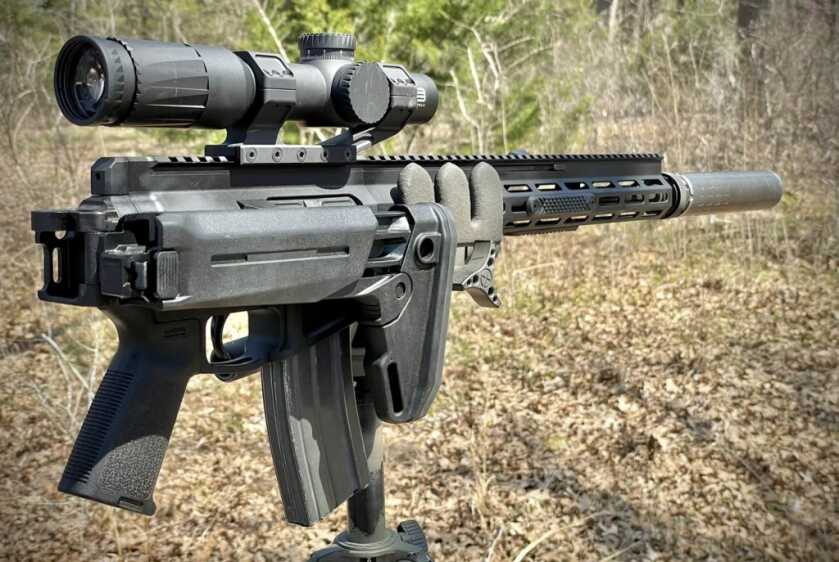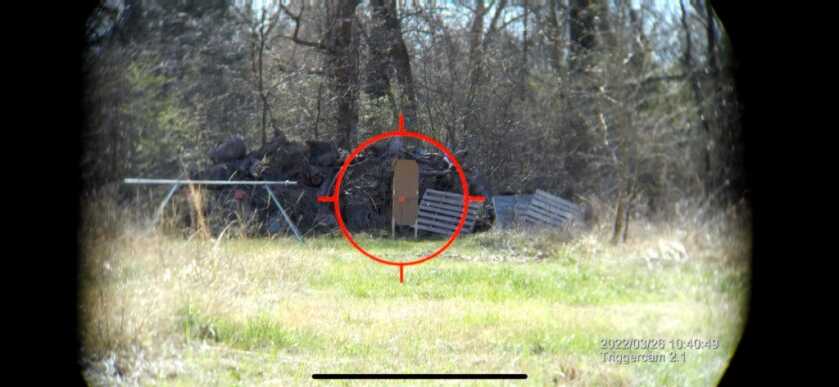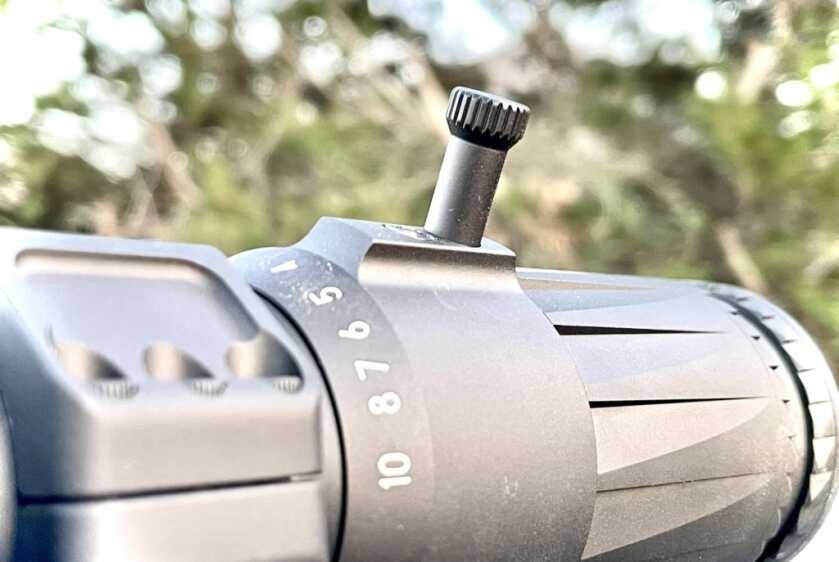
EOTECH announced the debut of its all-new 1-10 front focal plane (FFP) low power variable optic (LPVO) through its social media accounts for the first time back in December of 2021. Speaking to their reps at SHOT Show 2022, they aimed to start shipments in March and I immediately signed up for email notifications in anticipation. On March 7th I received the “products back in stock” alert and purchased my Vudu 1-10 within 2 minutes of receiving the email before they sold out. Keeping an eye on their website ever since it looks like they have yet to restock as of writing this, but hopefully, EOTECH will be able to continue ramping up production.
Before diving into further details, some of the highlights for the EOTECH Vudu 1-10 include low-profile “tactical” turrets with locking elevation, an illuminated reticle with three different patterns to choose from, a 34mm tube, and an XC anti-reflective lens all coming in at 21.3 ounces. The main body is machined from aircraft-grade aluminum and utilizes a black anodized finish. Out of the box, this scope feels solid and dependable.


First and foremost, I am a big fan of the reticles EOTECH offers in their VUDU lineup, but especially the two unique patterns available for the 1-10. There are three options as seen in the image below. There is one MOA option known as the SR-4, and then two MRAD options which included the SR-5 and the LE-5. The difference between the two MRAD options is just the center aiming dot. Only available as an FFP or front focal plane scope, this means that the reticle holdovers remain constant at any given magnification. This also means that as you zoom in, the reticle will get larger and allow you to use the hash marks to calculate your holds. I purchased the SR-5 which utilizes a 0.25 MRAD center aiming dot, whereas the LE-5 uses a precision cross-hair within the inner reticle pattern. While previous options didn’t have the “Christmas tree” style reticle, I love how much more information I have at my disposal for making those longer shots. When zoomed back out at 1X magnification, all the hash marks fade away and the user is left with a center dot inside the outer “donut-of-death.” I have found this to be a very useable and quick system when at 1X, and capable of calculated and precise shots at a distance when zoomed in between 6 & 10X.


For those who would like to see what this scope looks like when shooting through it click HERE to view a video I posted to my Instagram page about it. In the video, I show the reticle from 1 through 10X magnification, illuminated/not illuminated, and even some brief shooting. Now one thing I will say is that the illuminated reticle appears brighter in person than in the video, but that still does not mean it’s what many consider to be “daylight bright.” I would say it is identical to the brightness on their Vudu 1-6 scope that has been out a while. There are 10 brightness settings with a 2-hour auto-off feature, and with the illumination turned all the way up I find it to be more red dot-like but still not the same. With light backgrounds such as dead grass, snow, etc. on sunny days, the illuminated reticle loses its contrast and appears more like a typically non-illuminated etched reticle. While slightly disappointing, this is still a very useable and quick optic. The eye-box is good, and it is easy to pick up the reticle when running and gunning.

Now for the biggest downsides to the Vudu 1-10. First off, there is a pretty serious fish eye effect going on with the scope that distorts the outside 50% off the glass. When looking through the middle 50%, everything appears as I think it should. Even prone and not moving, the glass is clear and this effect is not very noticeable. However, when panning around on 1X with both eyes open it is very obvious. As I transition from one target to the other, the image warps until it is within the middle 40% of the scope. While the distortion does not appear as blurry to me as in the image below, it does cover the same area. This issue is non-existent in my Vudu 1-6 so I was disappointed when I first started testing out the new 1-10. The good news is that when zoomed in anywhere past about 2X this effect is not really noticeable anymore. I found it to only be troublesome on 1X and when transitioning between targets with both eyes open.

The second issue I had with this scope was in regards to clarity. When zoomed all the way out on 1X magnification, everything looked great. When zooming in all the way to 10X though, edge distortion became very noticeable and a blue hue appeared. Due to the edge distortion and fish eye effect, I contacted Eotech hoping I just got a lemon and they had me send it in for warranty issues. Three-ish weeks later they sent a new 1-10 back out and the edge distortion is nowhere near as bad as appears in the picture below. The fish-eye effect is still the same as the first scope I received, but the glass clarity was much better. While this makes me skeptical about the whole production lineup, two out of the three I have seen in person had good clarity.

Keeping tradition with the other optics in its lineup, the Vudu 1-10 uses three rubber push buttons for adjusting the brightness. The top button powers on or off the illumination while the two sides are used for either increasing or decreasing the brightness. After setting the appropriate brightness and turning off the illumination, the scope will remember the last setting and will power up to the same brightness that was used last. I find these buttons easy to use and adjust even with gloves or with cold hands.

The Vudu 1-10 utilizes a single CR2032 battery which powers the unit for an unspecified period of time. LPVO’s do not have near the battery life of red dots, and users will need to replace this battery fairly often if consistently used on the maximum brightness setting. A minor but cool feature I found was a type of rubber suction cup on the inside face of the battery cap. When the cap is screwed down and tightened it sticks to the battery, and when unthreading the cap to replace the battery, the single CR2032 comes right off with the cap. Throughout testing, I never had an issue with the illumination flickering, so this scope seems to maintain a solid connection with the battery.


An awesome feature that is included with the 1-10 that was not incorporated into EOTech’s 1-6 is a locking elevation turret. While I don’t see it as a necessary feature for bolt guns, these low-powered variable optics are designed for short to medium-range shots in typically quick response type scenarios. After running around with a slung rifle, or moving through tight spaces shooters want to know their optic is going to put bullets where their crosshairs are aimed, and utilizing a locking turret this scope should do just that. Pulling the cap straight up unlocks the elevation turret and will allow for dialing in shots if needed, and a quick press back down will lock it back in place. The windage turret is also capped to maintain a secure zero, but can easily be removed for zeroing rifles, or dialing in windage if desired on longer shots. Each of these turrets has very tactile adjustments so you can feel exactly how many MILs or MOA you have dialed. These perform as good as I could have hoped for, and I have absolutely no complaints here.

Both the elevation and windage turrets are toolless and can be adjusted for zeroing with a piece of brass. Another simple and great feature that minimizes the amount of gear needed to maintain your equipment. While forgetting tools can be frustrating, you now do not need to worry. Each turret also has nice serrations that make adjustments easy and keep your hands from slipping in adverse conditions.


As a quick test to verify the precision of the turrets, I shot a three-round group at exactly 100 yards (verified with three separate rangefinders) then dialed 10 MILs to shoot another 3 round-group, then dialed back to zero to shoot the final three-round group. Calculating the value of 10 MILs at exactly 100 yards theoretically should have shifted my group exactly 36 inches. In shooting groups with around a 2MOA gun, there is plenty of room for error, but I got a shift that aligned basically spot on with the sharpie mark I placed at 36 inches (group averaged 0.5″ higher). After dialing back down, my third group aligned with my first as well. This proved that dialing in shots should replicate the actual mills etched on the turrets. While this test would have been better with a sub-MOA gun, I used what I had available at the time.

Improving upon their previous LPVO’s, EOTECH incorporated a shortened throw lever for quick magnification adjustments. This stubby lever is a great length in my opinion and has a wider end with grooves for good grip. Previously the included throw lever was twice as long and could poke my belly when the rifle was slung, but this carries comfortably. The single-piece eyepiece also has grooves that help for gripping when adjusting the magnification if the throw lever is not utilized. Out of the box, the magnification is pretty stiff, but the more I work it the smoother it is getting. I would prefer for it to be on the stiffer end of the spectrum so the optic stays at 1X magnification even when slung and rubbing against your body.


Coming in with an MSRP of $1,799, the EOTECH Vudu 1-10×28 FFP is more competitive than some of the other optics in its category. While not yet widely available, the EOTECH Vudu 1-10’s are slowly shipping out and may show back up in stock soon. This scope includes some great features, but finding one to evaluate in person would be recommended. In the end, I think the 1-10 has enough pros to outweigh the cons so I will still be swapping it out for my Vudu 1-6 on my primary AR.
Specifications:
- Overall Length: 10.63″
- Weight: 21.3oz
- Magnification: 1-10X
- Tube Diameter: 34mm
- Objective Diameter: 28mm
- Power Source: CR2032
- Eye Relief:
- 1X: 3.27″-3.90″ 10X: 3.35″-3.62″
- Field-of-View @ 100 Yards:
- 1X: 116.6 ft 10X: 11.7 ft
- Country of Origin: Made in Japan
***Buy and Sell on GunsAmerica! All Local Sales are FREE!***


What’s the upper on your test rifle there? I’m looking for a solid bufferless side charger in 300BLK and I’d be curious to know what model that is